Georg Bökman
Stronger ViTs With Octic Equivariance
May 21, 2025Abstract:Recent efforts at scaling computer vision models have established Vision Transformers (ViTs) as the leading architecture. ViTs incorporate weight sharing over image patches as an important inductive bias. In this work, we show that ViTs benefit from incorporating equivariance under the octic group, i.e., reflections and 90-degree rotations, as a further inductive bias. We develop new architectures, octic ViTs, that use octic-equivariant layers and put them to the test on both supervised and self-supervised learning. Through extensive experiments on DeiT-III and DINOv2 training on ImageNet-1K, we show that octic ViTs yield more computationally efficient networks while also improving performance. In particular, we achieve approximately 40% reduction in FLOPs for ViT-H while simultaneously improving both classification and segmentation results.
A Framework for Reducing the Complexity of Geometric Vision Problems and its Application to Two-View Triangulation with Approximation Bounds
Mar 11, 2025



Abstract:In this paper, we present a new framework for reducing the computational complexity of geometric vision problems through targeted reweighting of the cost functions used to minimize reprojection errors. Triangulation - the task of estimating a 3D point from noisy 2D projections across multiple images - is a fundamental problem in multiview geometry and Structure-from-Motion (SfM) pipelines. We apply our framework to the two-view case and demonstrate that optimal triangulation, which requires solving a univariate polynomial of degree six, can be simplified through cost function reweighting reducing the polynomial degree to two. This reweighting yields a closed-form solution while preserving strong geometric accuracy. We derive optimal weighting strategies, establish theoretical bounds on the approximation error, and provide experimental results on real data demonstrating the effectiveness of the proposed approach compared to standard methods. Although this work focuses on two-view triangulation, the framework generalizes to other geometric vision problems.
DaD: Distilled Reinforcement Learning for Diverse Keypoint Detection
Mar 11, 2025Abstract:Keypoints are what enable Structure-from-Motion (SfM) systems to scale to thousands of images. However, designing a keypoint detection objective is a non-trivial task, as SfM is non-differentiable. Typically, an auxiliary objective involving a descriptor is optimized. This however induces a dependency on the descriptor, which is undesirable. In this paper we propose a fully self-supervised and descriptor-free objective for keypoint detection, through reinforcement learning. To ensure training does not degenerate, we leverage a balanced top-K sampling strategy. While this already produces competitive models, we find that two qualitatively different types of detectors emerge, which are only able to detect light and dark keypoints respectively. To remedy this, we train a third detector, DaD, that optimizes the Kullback-Leibler divergence of the pointwise maximum of both light and dark detectors. Our approach significantly improve upon SotA across a range of benchmarks. Code and model weights are publicly available at https://github.com/parskatt/dad
Flopping for FLOPs: Leveraging equivariance for computational efficiency
Feb 07, 2025Abstract:Incorporating geometric invariance into neural networks enhances parameter efficiency but typically increases computational costs. This paper introduces new equivariant neural networks that preserve symmetry while maintaining a comparable number of floating-point operations (FLOPs) per parameter to standard non-equivariant networks. We focus on horizontal mirroring (flopping) invariance, common in many computer vision tasks. The main idea is to parametrize the feature spaces in terms of mirror-symmetric and mirror-antisymmetric features, i.e., irreps of the flopping group. This decomposes the linear layers to be block-diagonal, requiring half the number of FLOPs. Our approach reduces both FLOPs and wall-clock time, providing a practical solution for efficient, scalable symmetry-aware architectures.
Affine steerers for structured keypoint description
Aug 26, 2024
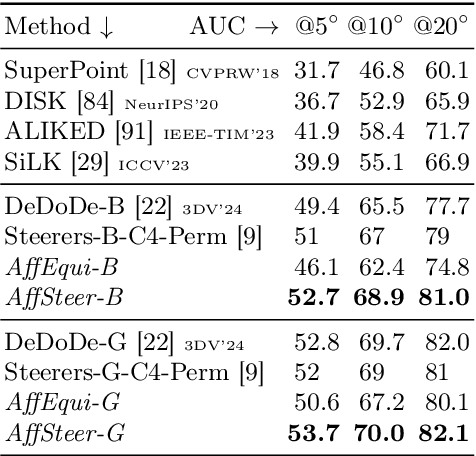
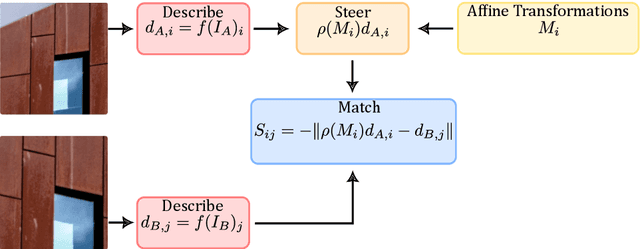
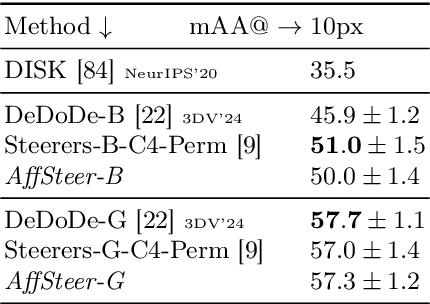
Abstract:We propose a way to train deep learning based keypoint descriptors that makes them approximately equivariant for locally affine transformations of the image plane. The main idea is to use the representation theory of GL(2) to generalize the recently introduced concept of steerers from rotations to affine transformations. Affine steerers give high control over how keypoint descriptions transform under image transformations. We demonstrate the potential of using this control for image matching. Finally, we propose a way to finetune keypoint descriptors with a set of steerers on upright images and obtain state-of-the-art results on several standard benchmarks. Code will be published at github.com/georg-bn/affine-steerers.
From 2D to 3D: AISG-SLA Visual Localization Challenge
Jul 26, 2024



Abstract:Research in 3D mapping is crucial for smart city applications, yet the cost of acquiring 3D data often hinders progress. Visual localization, particularly monocular camera position estimation, offers a solution by determining the camera's pose solely through visual cues. However, this task is challenging due to limited data from a single camera. To tackle these challenges, we organized the AISG-SLA Visual Localization Challenge (VLC) at IJCAI 2023 to explore how AI can accurately extract camera pose data from 2D images in 3D space. The challenge attracted over 300 participants worldwide, forming 50+ teams. Winning teams achieved high accuracy in pose estimation using images from a car-mounted camera with low frame rates. The VLC dataset is available for research purposes upon request via vlc-dataset@aisingapore.org.
DeDoDe v2: Analyzing and Improving the DeDoDe Keypoint Detector
Apr 13, 2024



Abstract:In this paper, we analyze and improve into the recently proposed DeDoDe keypoint detector. We focus our analysis on some key issues. First, we find that DeDoDe keypoints tend to cluster together, which we fix by performing non-max suppression on the target distribution of the detector during training. Second, we address issues related to data augmentation. In particular, the DeDoDe detector is sensitive to large rotations. We fix this by including 90-degree rotations as well as horizontal flips. Finally, the decoupled nature of the DeDoDe detector makes evaluation of downstream usefulness problematic. We fix this by matching the keypoints with a pretrained dense matcher (RoMa) and evaluating two-view pose estimates. We find that the original long training is detrimental to performance, and therefore propose a much shorter training schedule. We integrate all these improvements into our proposed detector DeDoDe v2 and evaluate it with the original DeDoDe descriptor on the MegaDepth-1500 and IMC2022 benchmarks. Our proposed detector significantly increases pose estimation results, notably from 75.9 to 78.3 mAA on the IMC2022 challenge. Code and weights are available at https://github.com/Parskatt/DeDoDe
Steerers: A framework for rotation equivariant keypoint descriptors
Dec 04, 2023Abstract:Image keypoint descriptions that are discriminative and matchable over large changes in viewpoint are vital for 3D reconstruction. However, descriptions output by learned descriptors are typically not robust to camera rotation. While they can be made more robust by, e.g., data augmentation, this degrades performance on upright images. Another approach is test-time augmentation, which incurs a significant increase in runtime. We instead learn a linear transform in description space that encodes rotations of the input image. We call this linear transform a steerer since it allows us to transform the descriptions as if the image was rotated. From representation theory we know all possible steerers for the rotation group. Steerers can be optimized (A) given a fixed descriptor, (B) jointly with a descriptor or (C) we can optimize a descriptor given a fixed steerer. We perform experiments in all of these three settings and obtain state-of-the-art results on the rotation invariant image matching benchmarks AIMS and Roto-360. We publish code and model weights at github.com/georg-bn/rotation-steerers.
ICML 2023 Topological Deep Learning Challenge : Design and Results
Oct 02, 2023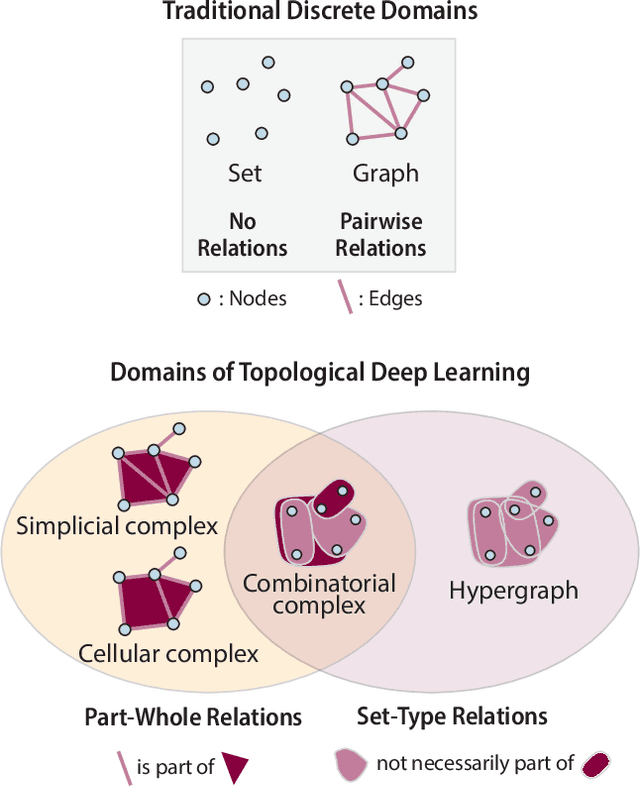
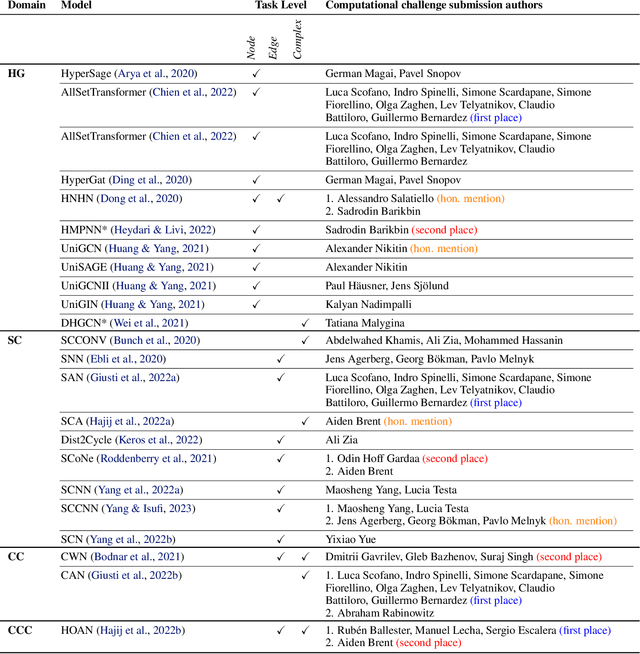
Abstract:This paper presents the computational challenge on topological deep learning that was hosted within the ICML 2023 Workshop on Topology and Geometry in Machine Learning. The competition asked participants to provide open-source implementations of topological neural networks from the literature by contributing to the python packages TopoNetX (data processing) and TopoModelX (deep learning). The challenge attracted twenty-eight qualifying submissions in its two-month duration. This paper describes the design of the challenge and summarizes its main findings.
Leveraging Cutting Edge Deep Learning Based Image Matching for Reconstructing a Large Scene from Sparse Images
Oct 02, 2023Abstract:We present the top ranked solution for the AISG-SLA Visual Localisation Challenge benchmark (IJCAI 2023), where the task is to estimate relative motion between images taken in sequence by a camera mounted on a car driving through an urban scene. For matching images we use our recent deep learning based matcher RoMa. Matching image pairs sequentially and estimating relative motion from point correspondences sampled by RoMa already gives very competitive results -- third rank on the challenge benchmark. To improve the estimations we extract keypoints in the images, match them using RoMa, and perform structure from motion reconstruction using COLMAP. We choose our recent DeDoDe keypoints for their high repeatability. Further, we address time jumps in the image sequence by matching specific non-consecutive image pairs based on image retrieval with DINOv2. These improvements yield a solution beating all competitors. We further present a loose upper bound on the accuracy obtainable by the image retrieval approach by also matching hand-picked non-consecutive pairs.
 Add to Chrome
Add to Chrome Add to Firefox
Add to Firefox Add to Edge
Add to Edge